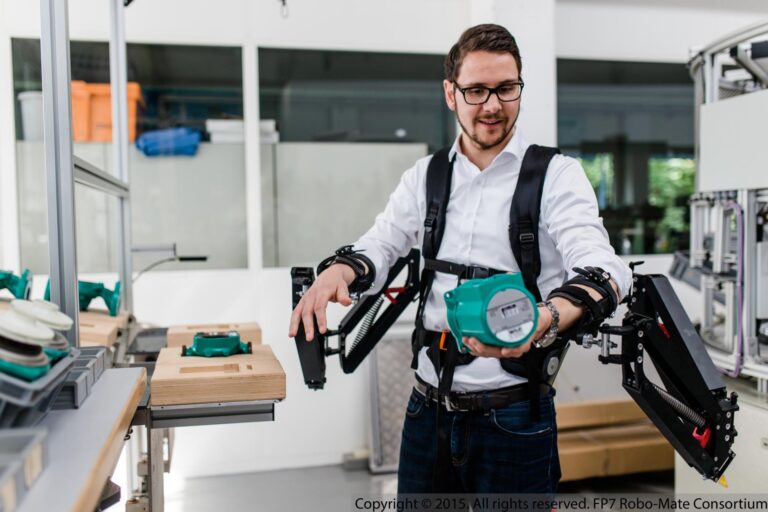The wearable technology uses electric motors and springs to augment the strength and balance of the human body. It has long been the subject of military research, but now engineers believe the technology is advanced enough to find much broader appeal.The IssueEurope’s manufacturing industry needs an edge in order to compete in a global marketplace.Research into robotics is one way of achieving this, giving Europe a high-tech advantage.In order to help stimulate innovation in manufacturing, the EU has teamed up with industry and academia in public, private partnerships such as thePartnership for Robotics in EuropeandFactories of the Future.‘We’re getting sufficient power for sufficiently low weight,’ said Dr Jan Veneman, a roboticist at Tecnalia Research and Innovation in Donostia, Spain.Exoskeletons typically consist of a framework that covers a person’s limbs. The framework has joints alongside the person’s own skeletal joints, and these are powered by motors or springs to assist in strength or endurance.Exoskeletons with motors are more flexible and more powerful, whereas those with springs can be made much lighter, according to Dr Konrad Stadler, an engineer at the Zurich University of Applied Sciences in Switzerland who is the technical project manager of the Robo-Mate project, which is working on an exoskeleton that could help manual workers.As part of the EU-funded project, he and his colleagues are designing different exoskeleton ‘modules’ to suit the different tasks carried out by manual workers.Compression forces‘Musculoskeletal injuries and disorders are caused by lower back compression forces, which result from the load carried and the worker’s own body weight, as well as the posture of the worker,’ says Dr Stadler.‘Lifting loads with outstretched arms will produce much larger compression forces in the lower back than lifting the same object close to the body.’By slipping on a Robo-Mate exoskeleton, a worker trying to carry a heavy object with outstretched arms ought to feel more like he or she is carrying it close to the body. Dr Stadler and colleagues are currently testing a prototype in the lab, and hope to be doing industrial tests next year.Article continues after the image.Robo-Mate has made a prototype of an exoskeleton. Image courtesy of Robo-MateBut exoskeletons are not all about strength. Dr Veneman is investigating whether exoskeletons can also be used to keep people stable as part of the EU-funded BALANCE project.The human body normally keeps itself balanced with two mechanisms: altering the stiffness of joints, or moving hands and feet to more stable positions. ‘It is very subtle where you place your foot,’ he explained. ‘If you place it too far, or too close, you can easily lose balance.’The aim of the BALANCE exoskeleton is to learn how the body does this naturally, and see whether the exoskeleton can assist the body to do the same thing. It is currently in the design stage, but Dr Veneman says the prototype should offer minimal resistance to movement, so that it can follow accurately the movements of healthy and infirm people.Give a pushOnce the system understands the human body’s balancing mechanisms sufficiently well, it should be able to replicate it. In theory, you should be able to give someone wearing the BALANCE prototype a push, and the system will move the person’s feet to stop them falling over.That will require a rather complex exoskeleton with multiple joints, and sensors that can detect instability.A simpler exoskeleton, and one with a good chance of commercialisation in the near future, is the one being developed within the EU-funded AXO-SUIT project, which is part of theEU’s Active and Assistive Living programmeto enhance quality of life for the elderly. The idea behind AXO-SUIT is to help elderly or infirm people perform basic everyday tasks, such as standing up, walking, reaching and grasping.“‘We’re getting sufficient power for sufficiently low weight.’Dr Jan Veneman, Tecnalia Research and Innovation, SpainThe technology behind AXO-SUIT is not dissimilar to that in an electric bike, says project lead coordinator Prof. Shaoping Bai of Aalborg University in Denmark. Rather than completely take over, the motors assist action that the user is already trying to perform, such as bending down to water the plants and standing back up again.AXO-SUIT is currently at the prototype stage. In about five years, however, Prof. Bai hopes that his group will have a commercial version costing between EUR 8 000 and EUR 10 000.That may sound expensive, but Prof. Bai believes the exoskeleton could replace a lot of costly personal care for the elderly. ‘It would be helpful for them to maintain their quality of life while staying at home, rather than move to a care centre,’ he said.
This article was originally published in Horizon, the EU Research and Innovation magazine.
Add to favorites:
Share:
Listing Description
Video
Documents
No documents available.
Ask KETMarket to make a contact
Connect with the Listing Owner!
💬 Please log in now to askKETMarket to make a contact. Not a member yet? Sign up for free and start connecting today!
Video
Related Funding and Finance Opportunities
Unlock Exclusive Funding Opportunities!
🔑 Get instant access to tailored funding opportunities that perfectly match your needs. This powerful feature is exclusively available to our premium members—helping you save time, stay ahead of the competition, and secure the right funding faster.
Upgrade to Premium now and never miss an important opportunity again! Already a premium member? Log in here to explore your matches.
Related Innovation Offers
Discover Tailored Innovation Offers!
🚀 Gain access to technology solutions that match your specific needs and interests—carefully selected to support your innovation goals. These offers are exclusively available to our premium members, helping you identify relevant technologies faster and start the right conversations with potential partners.
Upgrade to Premium now and explore your personalized technology matches today! Already a premium member? Log in here to view your tailored offers.
Related Knowledgeable Resources
Discover More with Premium: Related Knowledge Resources
🔒 You’re missing out on expert-curated knowledge specifically matched to this topic. As a Premium member, you gain exclusive access to in-depth articles, guides, and insights that help you make smarter decisions, faster.
Whether you’re preparing a funding proposal, researching a new market, or just need reliable information—our Premium knowledge matches save you hours of research and point you directly to what matters.
Upgrade to Premium now and instantly unlock relevant knowledge tailored to your needs! Already a member? Log in here to view your personalized content.

